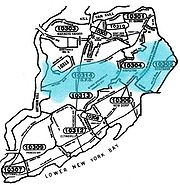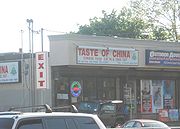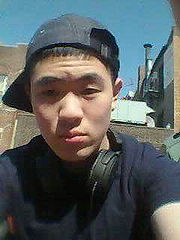From The Peopling of New York City
Contents |
Overview
In the year 2000, the Chinese community in Staten Island had a population of 7,490 people, which is 1.7% of the total population on the island. Between 1990 and 2000, the Chinese population increased by 46.7%. Staten Island had the densest Chinese population in the 10314 and 10305 zip code regions. Despite the 10314 zip code population being double the population in 10305, each region was 2.4% Chinese. It has only been in recent years that the Chinese population has greatly increased on Staten Island. This is noted in Chinese-American literature because authors wrote about early Chinese immigration to the United States, either autobiographies or informational documents. The first Chinese immigrants came to the United States in the early 1800’s, settling mostly on the West Coast in California. However, many made it to New York City, which is home to some of the most popular "Chinatowns" in the world. Chinese culture and history is represented in every Chinese cultural institution, and is easily recognized by many Americans.
Demographics
It has only been in recent years that the Chinese population in Staten Island has been rapidly increasing. The overall Chinese population in Staten Island in 1990 was 5,105, and in 2000 it raised to 7,490. These numbers represent 30.3% in 1990 and 29.9% in 2000 of the total Asian population on the island. The total population on Staten Island in 1990 was 378,706 people, and this increased to 442,588 people in 2000. The Chinese community represented 1.4% in 1990 and 1.7% in 2000 of the total Staten Island population. After taking a closer look at the numbers for the foreign-born Chinese population, data showed that there were 4,331 people (5.96% of the total foreign-born) in 2000.
In the same year (2000), New York City contained 7,614,319 people. Out of this population, 316,531 were Chinese. This is 4.5% of the NYC population. Therefore, the concentration of this community was denser in NYC by 2.8%. Out of the other four boroughs, only the Bronx had a less dense Chinese population. The Staten Island Chinese population is 1.2% denser than the Bronx. The rest of the boroughs, which include Brooklyn (3.2% Chinese), Manhattan (4% Chinese), and Queens (4.6% Chinese) all have a more densely populated Chinese community.
By zip code, Staten Island had the densest Chinese population in 10314 and 10305. Despite the 10314 population being double the population in 10305, each zip code was 2.4% Chinese. The zip code 10314 represents the neighborhoods Castleton Corners and New Springville, while 10305 includes Rosebank and Old Town. Between 1990 and 2000, the Chinese population increased on Staten Island from 5,105 to 7,490, which is a 46.7% increase. Throughout the twentieth century the Chinese population has continued to increase.
Several estimates have been made regarding the Staten Island demographic population on websites such as the U.S. Census Bureau’s American Community Survey. The population increased in each twenty-first century estimate. In 2004, the Chinese population was 8,907 people out of 454,131. The Chinese population then rose to 12,515 in 2006, and 13,973 in 2008. 2008 was the most recent estimate available. In this year, the Chinese was 2.9% of the total population. The only data unavailable was the population density of zip codes within these estimates. However, assuming that the zip codes follow the same pattern as the total Staten Island population, 10314 or 10305 would continue to have the densest Chinese population.
| Densest Community Zip Codes (2000) | |||||
| Zip Code | 10314 | 10305 | |||
| Total Population | 84,821 | 38,450 | |||
| Chinese Population | 2,052 | 907 | |||
| % of Total Population | 2.40% | 2.40% | |||
| Recent Estimates | |||||
| Year | 2004 | 2006 | 2008 | ||
| Total Population | 454,131 | 477,377 | 487,407 | ||
| Chinese Population | 8,907 | 12,515 | 13,973 | ||
| % of Total Population | 1.96% | 2.62% | 2.90% | ||
NYC | Staten Island | Brooklyn | Bronx | Manhattan | Queens | |
|---|---|---|---|---|---|---|
| Total Population | 7,614,319 | 443,728 | 2,465,326 | 1,322,650 | 1,537,195 | 2,229,379 |
| Chinese Population | 361,531 | 7,490 | 120,662 | 6,585 | 86,974 | 139,820 |
| % of Total Population | 4.50% | 1.70% | 4.90% | 0.50% | 5.70% | 6.30% |
| % Compared to Staten Island | 2.80% | N/A | 3.20% | -1.20% | 4.00% | 4.60% |
History
The first Chinese immigrants came to the United States in the early 1800s. Most lived on the West Coast. However, many made it to New York City, which is home to some of the largest Chinatowns in the world. As the Chinese population increased, the U.S. suspended Chinese immigration by passing the Chinese Exclusion Act. This greatly reduced their immigration until it was repealed in 1943. Chinese brought several things with them from China. A large number of the Chinese were Buddhist. Thus, the first Buddhist temple in the United States was established by Chinese Americans. They also brought many kinds of foods, an effect that can still be seen today.
One of the gaps in existing literature is the hardships Chinese faced during their immigration. This does not include the Chinese Exclusion Era simply because many Chinese did not immigrate during that time. Another gap is the Chinese population within Staten Island, New York. Almost no information was found regarding them. This may be because the Chinese have only recently become a large population on the island.
Politics was always an important dynamic of China, from the early years of Confucius to the first days of Communism. Many religions were also found in China, including Buddhism, Taoism, and Confucianism. The Chinese were known for their unique styles of art such as calligraphy. In the early years of China before immigration, many of their people lived a rural life in villages. China was also home to many schools of philosophy, some of which are still practiced today. Lastly, China has been able to preserve much of its history through mythology. Several creation myths and legends have been made concerning the founding of Chinese culture.
The People
Many of the local Chinese population on Staten Island came in recent years, mostly from other New York boroughs. Three Chinese American New Yorkers who currently live on Staten Island are Philip Ma, Annie Chen, and Justine Kwok.
Philip Ma was born on Staten Island in Port Richmond, and is currently finishing his freshman year at the Macaulay Honors College at the College of Staten Island.
Annie Chen was born in China, and moved to Staten Island from Manhattan a few years ago. She is currently the manager of the Chinese restaurant, The Taste of China, located at 90 Guyon Avenue in Staten Island.
Justine Kwok was born in Brooklyn, New York, and moved to Staten Island with her family when she was three years old. She is currently finishing her freshman year at Stony Brook University in Long Island.
These three individuals have very interesting stories and they describe how different Chinese culture is from American culture.
Ethnic Stages
"Ethnic Stages" refers to the locations on Staten Island or within the community on which people display their community membership and identity. This can mean churches, community centers, specialized stores with products from the home country, restaurants that serve the community's cuisine, or other sorts of institutions.
For the Chinese community, the main ethnic stages in Staten Island are restaurants. Chinese restaurants are located all over Staten Island and are very profitable. A particular restaurant that exemplifies Chinese culture is Empire East Chinese and Pan Asian Cuisine. It is located along the extremely busy Hylan Boulevard in a shopping center, surrounded by convenience stores and other restaurants. Empire East offers various types of Chinese dishes, and also dishes of other countries like Japan and India. The restaurant unifies both Chinese and American cultures by taking parts of both and mixing it together. By "Americanizing" their restaurants, the Chinese people can feel assimilated into the American culture and way of life, while also contributing their rich culture to Americans.
Readings
Baird, Susan G. “American Chinatown: A People’s History of Five Neighborhoods.” Library Journal 134.13 (2009).
Chai, May-Lee, and Winberg Chai. China A to Z: Everything You Need to Know to Understand Chinese Customs & Culture. New York: Plume, 2007.
Chan, Sucheng. <i>Chinese American Transnationalism: The Flow of People, Resources, & Ideas Between China & America during the Exclusion Era. Philadelphia: Temple University Press, 2006.
Christie, Anthony. Chinese Mythology. London: Hamlyn, 1968.
Creed, Haymond. Chinese Immigration. Sacramento: State Printing Office, 1877.
Creel, Herrlee Glessner. Chinese Thought, from Confucius to Mao Tse-tung. Chicago: University of Chicago Press, 1953.
Froncek, Thomas, and Hugh Honour. The Horizon Book of the Arts of China. New York: American Heritage Pub. Co., 1969.
Gyory, Andrew. Closing the Gate: Race, Politics, and the Chinese Exclusion Act. Chapel Hill: University of North Carolina Press, 1998.
Ho, Adrian. “Dude, Where’s My Dumpling?” Wall Street Journal – Eastern Edition. 254.138. (2009): A19.
Jeung, Russell. Faithful Generations: Race & New Asian American Churches. New Brunswick: Rutgers University Press, 2005.
LaFleur, Robert Andre. China: A Global Studies Handbook. Santa Barbara, Calif: ABC-CLIO, 2003.
Lin, Yutang. The Wisdom of Confucius. New York: Modern Library, 1938.
Mosher, Steven W. Broken Earth: The Rural Chinese. New York: Free Press, 1983.
Perkins, Dorothy. "The Essential Reference to China, Its history and Culture." Encyclopedia of China. 4. New York: Facts on File, 1999.
Sifton, Sam. “The Way We Eat: New York Noodletown.” New York Times Magazine. (2007): 57.
Spence, Jonathan D. The Chan’s Great Continent: China in Western Minds. New York: W.W. Norton, 1998.
Yang, Fenggang, & Helen Rose Ebaugh. “Religion & Ethnicity Among New Immigrants: The Impact of Majority/Minority Status in Home & Host Countries.” Journal for the Scientific Study of Religion. 40.3 (2001): 367-378.
Yee, Shirley J. “Dependency & Opportunity: Socioeconomic Relations between Chinese & Non-Chinese in New York City, 1870-1943.” Journal of Urban History. 33.3 (2007): 254-276.
Zhu, Liping. A Chinaman’s Chance: The Chinese on the Rocky Mountain Mining Frontier. Niwot: University Press of Colorado, 1997.
The World’s Great Religions. New York: Time, Inc., 1957.
Further Research
Relevant LOC Subject Headings:
• Chinese -- Chinatown -- New York City. • Chinese -- Resources. • Chinese -- Immigration -- United States. • Chinese -- Exclusion. • Chinese -- New York City -- Food. • Chinese -- United States. • Chinese -- New York City -- Food. • Chinese -- Buddhism -- United States. • Chinese -- New York City -- Ethnicity. • Chinese -- Immigration -- United States. • Chinese -- Clothing. • Chinese -- Philosophy. • Chinese -- Mythology. • Chinese -- Calligraphy. • Chinese -- Food. • Chinese -- Confucius. • Chinese -- Rural. • Chinese -- Taoism. • Chinese -- Buddhism.
Relevant Keywords:
• Chinese • Immigration • United States • New York City • Chinatown • Exclusion • Resources • Food • Ethnicity • Religion • Confucius • Khan • Buddhism • Taoism • Calligraphy • Rural • Food • Clothing • Philosophy • Mythology • Social Life • Customs • Social Conditions • China • Encyclopedia • Art





